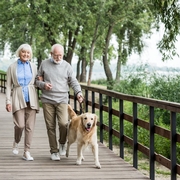Information you need to live a happy, worry-free retirement!
Originally published March 28, 2019, last updated April 24, 2019
Bone Breaks Are Up Among Older Adults Walking Dogs

Injuries caused by walking a dog on a leash have doubled in the past 15 years for Americans 65 years old and older, according to a new report published in the journal JAMA Surgery.
In examining more than a decade of federal injury data at 100 U.S. emergency departments nationwide, researchers from the University of Pennsylvania noted that broken bones linked to walking a dog jumped from 1,671 in 2004 to 4,396 in 2017 for those age 65 and older.
More than a quarter of the injuries (28.7%) were severe enough to require hospitalization. More than three-quarters of the fractures (78.6%) occurred in women. The most commonly fractured body part was the hip (17.3%). Next was the wrist (13.7%), followed by the upper arm (11.1%).
Weigh the Benefits and Risks of Dog Walking
"Dog walking, which has repeatedly demonstrated social, emotional and physical health benefits, is a popular and frequently recommended activity for many older Americans seeking new ways to stay active," said the study's lead author Kevin Pirruccio, a second-year medical student in the Perelman School of Medicine at the University of Pennsylvania, in a release on the study. "This study highlights that while there are undoubtedly pros to dog walking, patients' risks for falls must be factored into lifestyle recommendations in an effort to minimize such injuries."
How to Walk the Dog Safely
Dogtime.com suggests that you check the weather and avoid going out if sidewalks could be slippery and that you wear appropriate shoes with good traction.
Don’t wrap your leash around your hand to safely secure your dog, because that could be unsafe for you if the dog jerks or takes off quickly, said Mark Cohen, M.D., and director of the Section of Hand and Elbow Surgery at rush University Medical Center in Chicago.
What to Do If You Fall
The National Institute on Aging suggests that if you do fall, take a few deep breaths to relax and remain still on the ground for a few moments.
Decide if you are hurt before getting up, and if you think you can get up safely without help, roll onto your side. Go slow, resting so your body and blood pressure can adjust. Slowly get up on your hands and knees, and crawl to something sturdy to help yourself up.
Put your hands on the sturdy object and slide one foot forward, putting it flat on the ground. Rise slowly from this kneeling position.
If you are hurt or cannot get up on your own, ask someone for help or call 911. If you’re alone, try to get into a comfortable position and wait for help to arrive. You also may want to take a cell phone with you or an emergency response system, which lets you push a button on a special necklace or bracelet to call for help.



